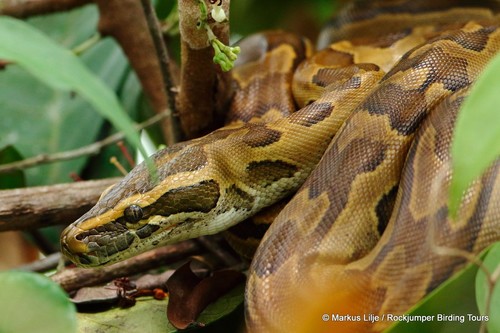
African Rock Python
The African rock python, Python sebae, is a formidable constrictor native to sub-Saharan Africa. Renowned for its immense size and striking patterned scales, it thrives in varied habitats. As a top predator, it balances ecosystems by preying on mammals and birds, while its camouflage aids in stealthy hunting.
Length: 2.74 - 7.62 m
Size
Yellow, Dull, Olive, Grey-Brown
Color
Near Threatened
Conservation Status
Decreasing
Population Trend
Characteristics
Python sebae, commonly known as the African rock python, is one of the largest snake species, reaching lengths of up to 7 meters. It inhabits diverse environments across sub-Saharan Africa, from savannas and forests to swamps. This non-venomous constrictor preys on mammals and birds, showcasing impressive strength and hunting prowess. Its patterned scales provide effective camouflage, and it plays a vital role in controlling prey populations within its ecosystem.
Distribution Range of the African Rock Python
Python sebae, commonly known as the African rock python, is native to sub-Saharan Africa. Its geographical distribution spans a wide range across the continent, including countries such as Senegal, Mali, Sudan, Ethiopia, Uganda, Kenya, Tanzania, Angola, and South Africa. This species is primarily found in the central and southern parts of Africa, avoiding the dense rainforests of the Congo Basin.
African Rock Python's Habitat
Environmental Conditions
The African rock python inhabits a variety of environments, including savannas, grasslands, and open forests. It is often found near water sources such as rivers, lakes, and swamps, as it is an excellent swimmer. The climate in its habitats ranges from tropical to subtropical, with distinct wet and dry seasons. Temperatures can vary significantly, but generally remain warm throughout the year.
Ecological Niche
As a large constrictor, the African rock python occupies the ecological niche of a top predator in its environment. It preys on a variety of animals, including rodents, birds, antelopes, and occasionally even larger mammals. Its ability to adapt to different habitats and its wide prey base allow it to thrive in diverse ecological settings. Despite its adaptability, it prefers regions with ample cover and access to water, which supports both its hunting and thermoregulatory needs.
Copyright @ Nature Style Limited. All Rights Reserved.
 English
English